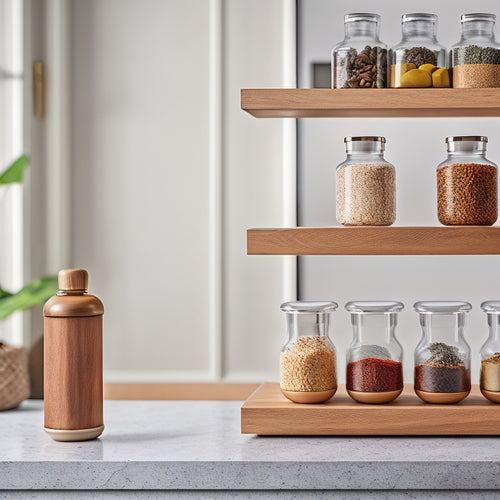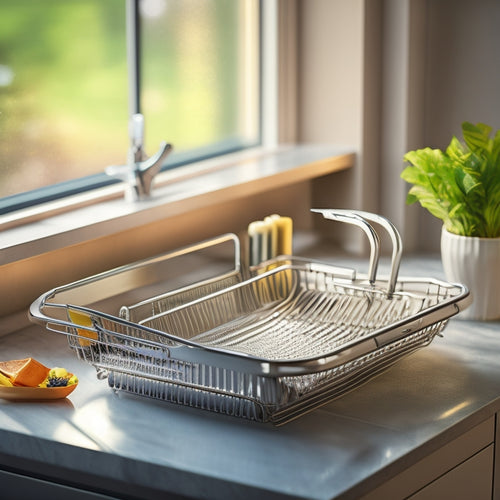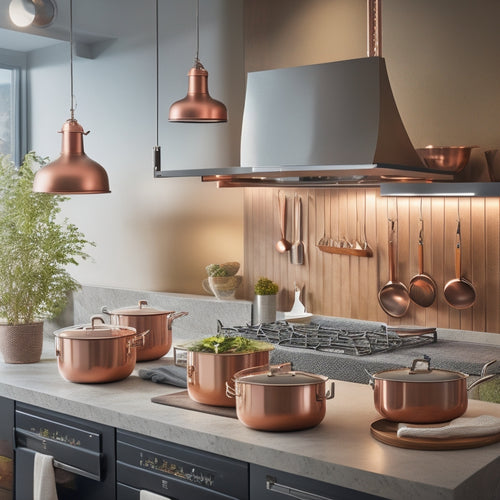
Why Age-Friendly Kitchens Are a Must for Seniors
Share
You're likely to spend more time in your kitchen as you age, so having a space that accommodates your changing needs and abilities is vital. Age-friendly kitchens can greatly enhance your quality of life by reducing strain and discomfort. By incorporating senior-friendly essentials like ergonomic utensils, user-friendly layouts, and adjustable counters, you can create a safe and comfortable cooking environment. Additionally, optimizing appliance placement, accessibility in design, and comfortable seating areas can make a huge impact. As you explore ways to create your ideal kitchen, you'll discover how these simple yet thoughtful touches can make a world of difference in your daily life.
Key Takeaways
• Age-friendly kitchens promote independence, allowing seniors to cook and prepare meals safely and confidently without relying on others.
• Senior-friendly design elements, such as ergonomic utensils and non-slip flooring, reduce the risk of accidents and injuries in the kitchen.
• Easy-to-use appliances and accessible storage solutions minimize strain and discomfort, enabling seniors to cook with ease and comfort.
• Age-friendly kitchens can help prevent feelings of isolation and loneliness by providing a comfortable space for socializing and entertaining.
• Universal design elements in age-friendly kitchens accommodate changing needs and abilities, ensuring the space remains functional and safe as seniors age.
Senior-Friendly Kitchen Essentials
As you design or renovate your kitchen to accommodate your golden years, incorporating senior-friendly essentials becomes essential to maintaining independence and safety while cooking.
You'll want to prioritize ergonomic utensils that fit comfortably in your hand, reducing strain and discomfort.
A user-friendly layout is also pivotal, allowing you to navigate the space with ease. Consider an open floor plan, which eliminates obstacles and creates a clear path to essential areas like the sink, stove, and refrigerator.
Adjustable counters will also become your new best friend. These can be customized to a comfortable height, reducing strain on your back and joints.
Slip-resistant flooring is another must-have, providing traction and preventing falls. You can opt for textured tiles, non-slip mats, or even install a floor with built-in grip strips.
Easy-to-Use Appliance Placement
You'll notice that strategically positioning appliances in your kitchen can make a significant difference in your cooking experience, enabling you to work efficiently and safely. As you age, optimizing your kitchen layout to reduce strain and discomfort is crucial. This is where appliance organization and ergonomic design come into play.
Here are some essential tips:
-
Place frequently used appliances at convenient heights to avoid bending or stretching.
-
Position heavy appliances, like refrigerators and ovens, in easily reachable locations to minimize strain.
-
Install appliances with user-friendly controls, such as large buttons or touch screens, to simplify cooking tasks.
- Contemplate a 'work triangle' layout, where your most-used appliances form the points of a triangle, reducing walking distances and enhancing workflow.
Accessibility in Kitchen Design
As you design an age-friendly kitchen, you'll want to prioritize accessibility to guarantee seniors can cook and socialize safely and independently. Six essential elements of accessibility in kitchen design can significantly impact the independence and safety of seniors: flooring, lighting, countertops, sinks, faucets, and storage.
These elements can be integrated into a universal design that benefits users of all ages and abilities. A functional layout is key, allowing seniors to move easily around the kitchen without obstacles.
Here are some accessibility features to contemplate:
| Feature | Benefits |
|---|---|
| Non-slip flooring | Reduces fall risk, provides traction |
| Task lighting | Enhances visibility, reduces eye strain |
| Lowered countertops | Enables comfortable standing or seated work |
Comfortable Seating Areas
Incorporating comfortable seating areas into your age-friendly kitchen design creates inviting spaces where seniors can rest, socialize, and recharge. A well-designed seating area can greatly impact the overall comfort and functionality of the kitchen.
When designing a seating area, consider the ergonomic design and functional layout to make sure it meets the needs of seniors.
Here are some key considerations to keep in mind:
-
Choose chairs with sturdy arms and a firm, cushioned seat to provide support and comfort
-
Position seating areas near natural light sources to boost mood and visibility
-
Incorporate tables or countertops with rounded edges to prevent injury and facilitate conversation
- Consider adding a built-in charging station for devices to keep seniors connected and entertained.
Simple Storage Solutions
Effective storage solutions can simplify your kitchen workflow, reducing frustration and fatigue by keeping essential items within easy reach. As you age, optimizing your kitchen storage to accommodate your changing needs is crucial. Here are some organization tips and space savers that are vital:
| Storage Solution | Benefits | Tips |
|---|---|---|
| Pull-out shelves | Easy access to heavy items | Install at convenient heights |
| Adjustable shelving | Customize storage to fit your needs | Use dividers to segregate items |
| Spice racks | Keep frequently used items organized | Mount near cooking stations |
| Lazy susans | Reduce bending and straining | Use in corner cabinets or pantries |
| Drawer organizers | Maximize drawer space | Use dividers to separate utensils and cookware |
Minimal Maintenance Features
You'll appreciate kitchen features that minimize maintenance, saving you time and energy for more enjoyable activities.
A low-maintenance kitchen is a must-have for seniors, as it allows you to focus on cooking and socializing rather than scrubbing and cleaning.
Here are some features to look for:
-
Easy-to-clean surfaces: Look for countertops, sinks, and faucets with smooth, non-porous surfaces that resist bacteria and stains.
-
Smart technology: Invest in smart appliances with self-cleaning modes, automated shut-off, and touchless controls to reduce mess and effort.
-
Ergonomic design: Opt for ergonomic layouts that reduce bending, stretching, and straining, making it easier to cook and clean without fatigue.
- Durable materials: Choose materials that withstand heavy use and require minimal upkeep, such as stainless steel, quartz, or ceramic.
Safety First Kitchen Features
Safety becomes your top priority as you navigate the kitchen, and thoughtful design elements can greatly reduce the risk of accidents and injuries. You want to feel confident and secure while cooking and preparing meals. That's why incorporating safety-first features is vital.
For instance, installing slip-resistant flooring can prevent slips and falls, which are common hazards in the kitchen. Adjustable countertops are also a must, allowing you to work at a comfortable height and reducing strain on your back and joints.
Proper lighting is also essential for safety. Bright lighting can help you see what you're doing, reducing the risk of accidents. Additionally, easy-to-reach shelving can help prevent overreaching and straining, making it easier to access the items you need.
Frequently Asked Questions
Can Seniors With Dementia Still Cook Independently in an Age-Friendly Kitchen?
You'll be relieved to know that, with some adaptations, seniors with dementia can still cook independently in an age-friendly kitchen, despite dementia challenges, as long as you prioritize cognitive decline considerations and kitchen safety features.
How Do I Balance Style With Functionality in an Age-Friendly Kitchen?
When designing an age-friendly kitchen, you'll balance style with functionality by incorporating design tips like custom options, prioritizing safety features, and making intentional decor choices that promote independence and accessibility.
Can Age-Friendly Kitchens Be Designed for Wheelchair Users?
"As you envision a kitchen that welcomes everyone, you're paving the way for freedom. Yes, age-friendly kitchens can be designed for wheelchair users by incorporating accessible design and a functional layout that accommodates their needs."
Are There Any Government Incentives for Creating Age-Friendly Kitchens?
You'll be happy to know that yes, there are government incentives to help offset renovation costs, making it more affordable for you to create an age-friendly kitchen that's safe and accessible for loved ones.
Can I Convert My Existing Kitchen Into an Age-Friendly Space?
"Get ready to flip the script on your kitchen, just like Grandma used to! You can totally convert your existing kitchen into an age-friendly space by rethinking the layout for easier navigation and incorporating essential safety features."
Related Posts
-

Modern Countertop Spice Organizer Designs
Modern countertop spice organizer designs enhance your kitchen's aesthetics while maximizing functionality. These spa...
-

Rust-Resistant Dish Drainers for Long-Lasting Use
If you're looking for rust-resistant dish drainers, focus on materials like high-grade stainless steel for superior c...
-

Ceiling-Mounted Pot Racks for Professional Chefs
Ceiling-mounted pot racks are revolutionary for professional chefs like you. They make use of vertical space, keeping...


